From the Archives, June 11, 2008
Story and color photos by Roberto Motta
This Alfa Romeo T33/2 is powered by the two-liter Alfa Romeo V8, still with its original 240 horsepower and in its original 1967 European Mountain Championship configuration.
Alfa Romeo’s history of racing started before World War I, and continued in 1950 and 1951 when the Type 158 and Type 159 won the first two World F1 Championships while the Disco Volante (6C 3000 CM) sportscar was still competitive in 1954. Despite the successes, Alfa Romeo decided to stop its racing in order to focus its attention on the production of their 1900 and 1300 cc street cars.
Some years later, the Italian factory decided to return to sports car racing with the Giulietta SZ, and then with fantastic Giulia TZ 1 and TZ 2 (TZ= Tubolare Zagato; Tubolare=tubular frame and Z=Zagato.) The TZs had a light alloy body, disc brakes, and independent suspension for superior handling and performance.
The TZ was built under the technical direction of Carlo Chiti of Autodelta, Alfa’s new competition department. After the TZ, the Autodelta produced the Giulia 1600 GTA and also this car was a dominant force in many racing Championships.
During the summer 1966, the Alfa Romeo’s manager, Giuseppe Luraghi, decided to create a new Sport 2 liters for the World Constructors Championship. The new Sport-Prototype was a two-seater which was given the codename ‘105.33’ but became known as the ’33’ . Original factory drawings indicate that since it was a two liter, it was also tagged the T33/2, later creating some confusing as to how to designate the ‘series 2’ cars in 1968.
In the Autodelta workshop, Carlo Chiti developed a 1600cc engine version, and then used all the experience he had already gained from the 1500 V8 ATS Grand Prix car, designed and produced the new Alfa Romeo V8 engine. The engine was installed in a rear engine chassis, which was a development of the OSI/Scarebo experimental show cars.
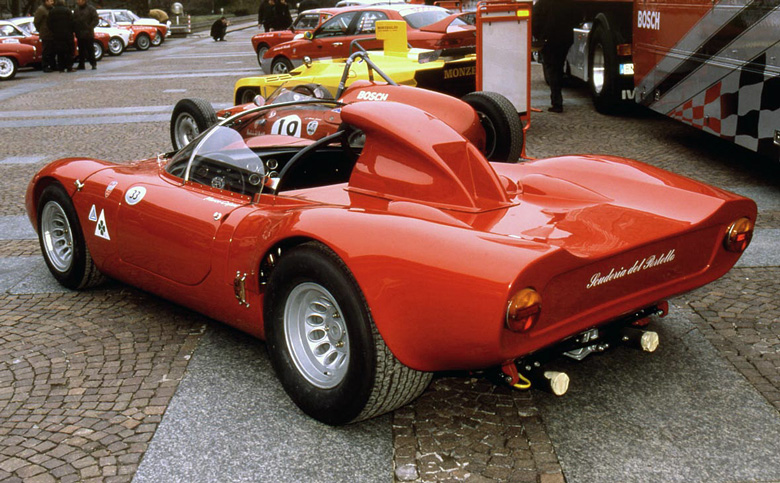
The large intake behind the driver looked like a periscope, and the cars gained the nickname “periscopica” Alfas.
On the 7th January 1967, The 33/2 had its shakedown at Monza circuit, where Teodoro Zeccoli drove the car in secret tests exclusively on the Alfa Romeo private track at Balocco. It was not a good day for the Alfa Romeo and due to ice on the track, or lack of brakes, Zeccoli lost control of the car. The car crashed and then burned. Fortunately, before the impact, the driver was thrown clear from the cockpit but Zeccoli remained in the hospital for two weeks. It is believed that this car was chassis 002.
Please don’t forget to become a VeloceToday Premium Subscriber!
Three months later, Alfa tried again. On 6th March, the 33/2 ‘periscopica’ was officially introduced to the press in the presence of the Ing. Carlo Chiti and the drivers Roberto Bussinello, Ignazio Giunti, Teodoro Zeccoli, and Giacomo Russo (Geki).
During the launch, Luraghi said to the journalists: “This car is the official announcement of the return of Alfa Romeo to the sport of racing with a car purposely constructed. In the best tradition Alfa Romeo is ready to enter sportingly into battle.”
Only a week later, on 12th March, the 33/2 driven by Zeccoli, triumphed at Fléron, a small town near Liege, in Belgium. Alfa took two cars to the event, and it is believed that chassis 75033-001 was driven by Zeccoli.
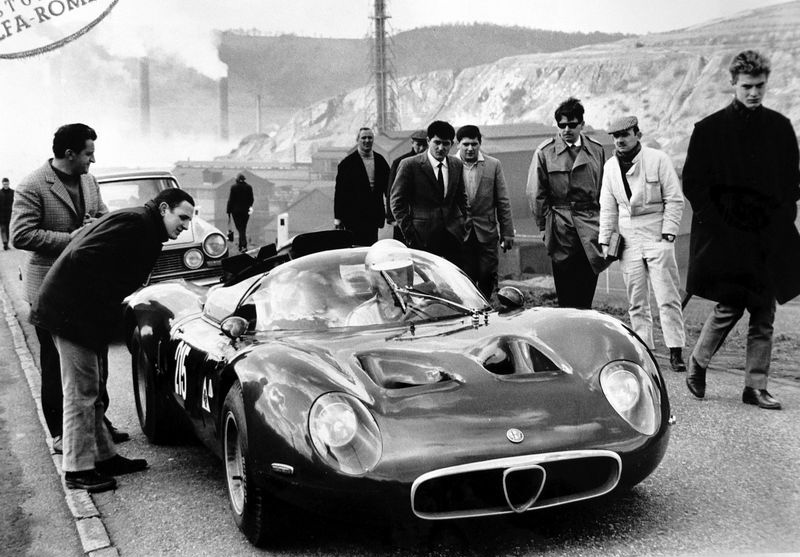
On 12 March 1967 (a little more than 50 years ago), the 33/2.001, Alfa’s first mid-engined racer made its competition debut at the Fléron Hillclimb in Belgium. The car was enrolled for the factory test drive Teodoro Zeccoli and won the competition. Photo courtesy Centro Documentazione Alfa Romeo – Arese.
In this article we would like present to the reader the car that won at Fléron and is currently owned by Marco Cajani. This car is still in Italy near Milano, and Cajani has all the documents which confirm that this 33/2 was used at Fléron and in other tests, for example, during the trials for the Targa Florio.
When Cajani saw this 33/2 at Alfa Romeo in 1986, and negotiated to purchase it, the car had a complete, original chassis with suspension, engine and all the parts except the body. Some year later, after long searches throughout Europe, Cajani was ready to rebuild the car.
The Alfa T33/2 is dominated by the presence, on the rear flat deck, of a huge snorkel air intake, and for this reason this car immediately was given the nickname ˜Perisopica.’ The snorkel’s function is to feed cool air to the engine and to the inboard rear brakes.
The first Tipo 105.33, has an unusual chassis that was designed using aeronautical techniques and was built by an aircraft company, Aereaonautica Sicula. The frame is made from three pieces of aluminum tubing 1520 mm long and 200 mm in diameter. The pieces are riveted together and form an ‘H’. Inside at the lateral pieces, there are a synthetic fuel tanks with the capacity of 98 liters (25.88 gal).
At the front, there is a magnesium casting that connects the two ends and provides space to mount the pedals, master cylinder and the steering gear.
The front suspension assemblies use transverse swinging arm, spring and shock absorbers that work vertically, and an anti roll bar. The rear suspension assemblies use spring and shock absorbers that are mounted in an inclined position, anti roll bar and a longitudinal control arm.
The engine is a 90-degree V8 with chain-driven twin-overhead camshafts on each bank with an aluminum cylinder block and wet liners. The crankshaft has five main bearings and is lubricated by dry sump system. The valves, two per cylinder, are closed by triple coil valve springs. Bore and stroke are 78 mm x 52.2 mm, total capacity is 1995.4 cc (121.7 cu in). With a compression ratio of 11.1:1, fed by four huge 46 IDF2 Webers carburetors and with only one plug per cylinder, the Alfa Romeo V8 power unit developed a power output of 230-240 bhp at 8000 rpm.
The 33/2-Fleron uses a manual six speed transmission and mechanical limited-slip differential. This special transmission was made by Alfa Romeo. The car has four ventilated disc brakes, with double-piston brake calipers. The front disks are mounted at the wheels and the rear disks are mounted inboard with the differential. The wheels are magnesium and the front tires measure 525 x 13″ and the rear 600-700 x13″.
The car declared a weight of 580 kg (1278.68 lbs), a wheelbase of 2250 mm, overall width of 1380 mm, overall length 3600 mm, front track of 1325 mm and rear track of 1690 mm.
After the restoration, Marco Cajani decided to use the car carefully, and not to race it, because this 33/2 is a wonderful rarity and also because it has a lot of magnesium parts, a very precious and delicate material. (When the first car burned at Monza, the fire refused to go out as the magnesium kept re-igniting.)
“This car is able to exceed 260 km/h (161.6 mph),” Cajani told us, “so we have had to rebuild it with safety and maintenance in mind.” Cajani said that during the restoration, all the magnesium parts were x-rayed, in order to find any anomalies. “Also, following the advice of Ing. Chiti, we have decided to use the Weber carburetors, (instead of fuel injection) so as to conserve the original qualities of the engine. Now, after a lot of time, the car is working perfectly,” continued Cajani. “It is our intention to drive the T33/2 on those circuits on which it has written great history.”
Cajani is pleased with the performance as well. “On the track the 33/2 reveals to the driver to be a car with a true sporty vocation with a generous engine that, over the 3500 rpm, can be pushed with brio without any decrease of vigor in all the rpm ranges.”
In summary, the T33/2 is a car of compact external dimensions with substantial attributes and values that are encoded in Alfa Romeo DNA.
June 20, 2008
After some discussion regarding the use of the number ‘/2’ after the Tipo 33, Roberto Motta has sent us verification of the 33/2 question. Initially, the ‘2’ did mean ‘two liters’ and was indicated as such on 1967 factory drawings and brochures which he has sent to us. It was previously thought that the T33/2 designation was applied only to the series 2 cars from 1968. Mr. Motta has proven otherwise.
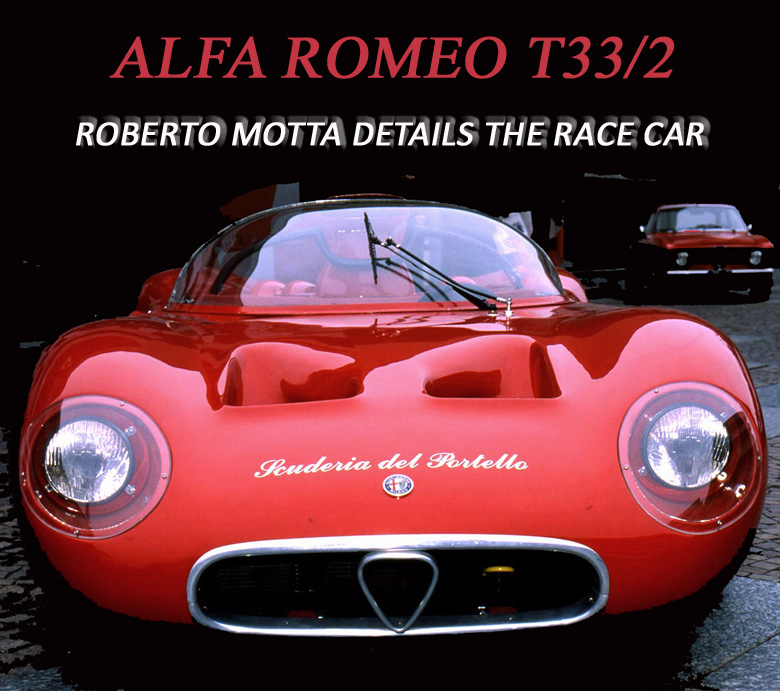
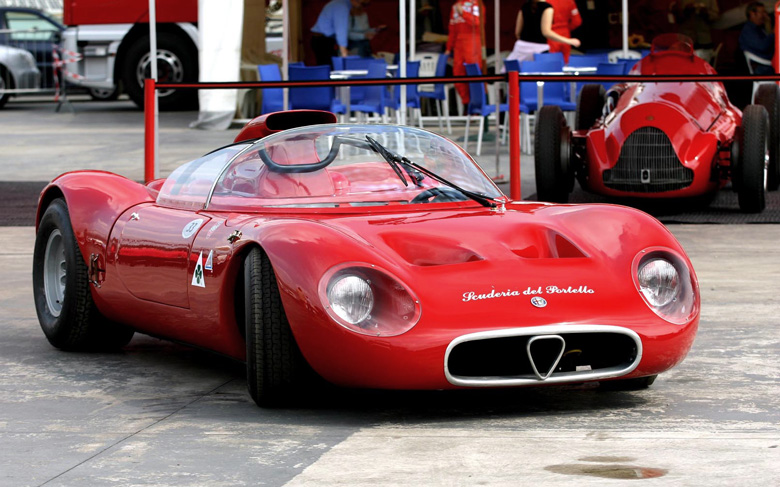
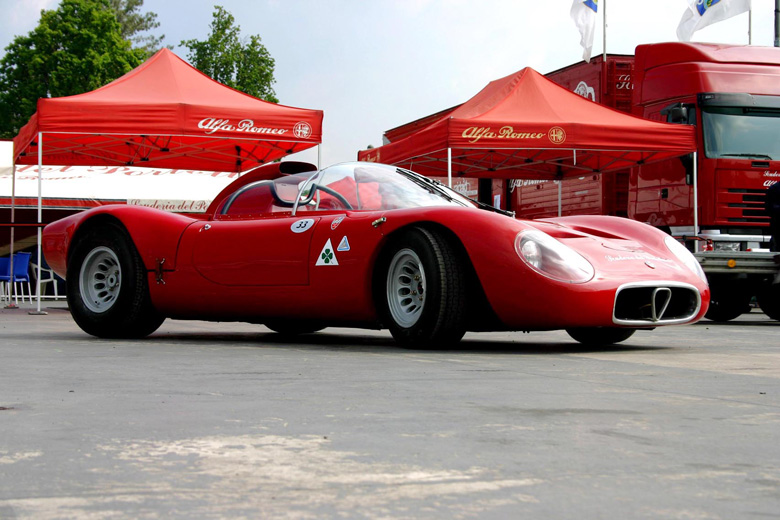
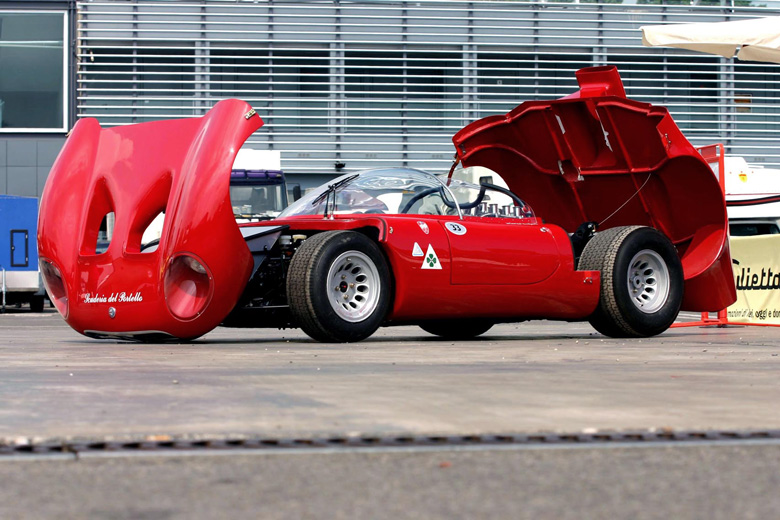
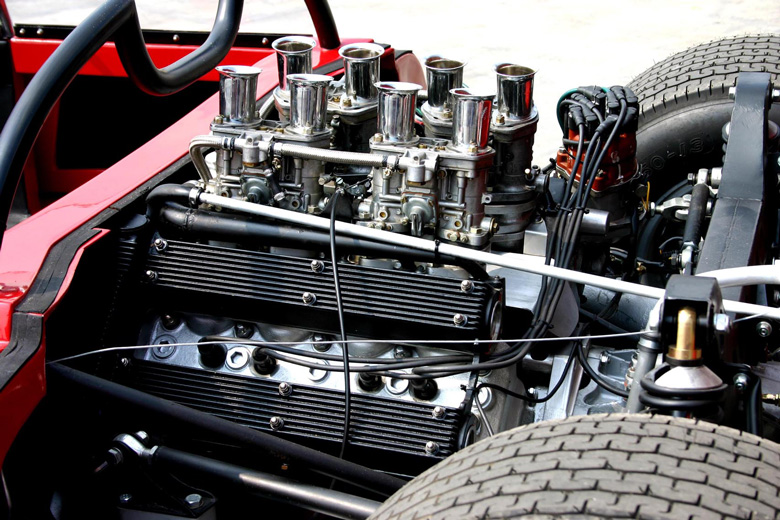
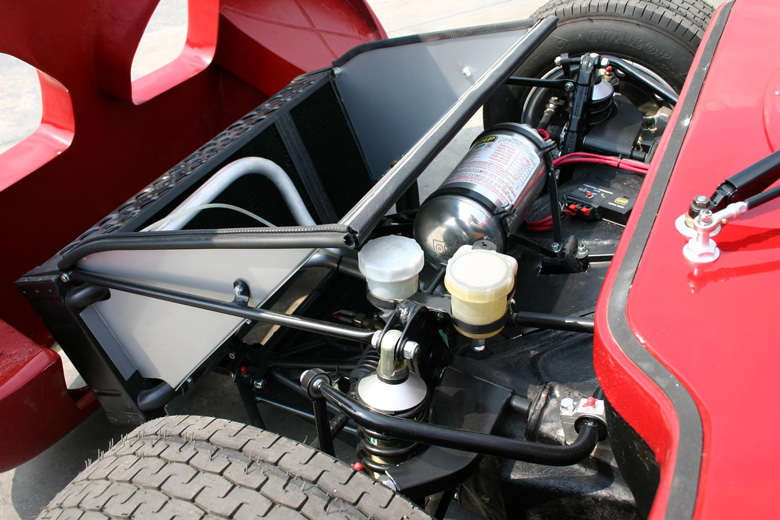
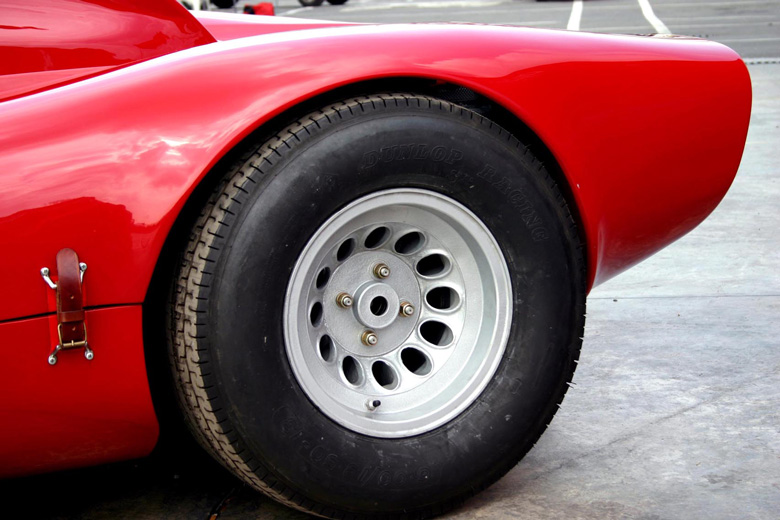
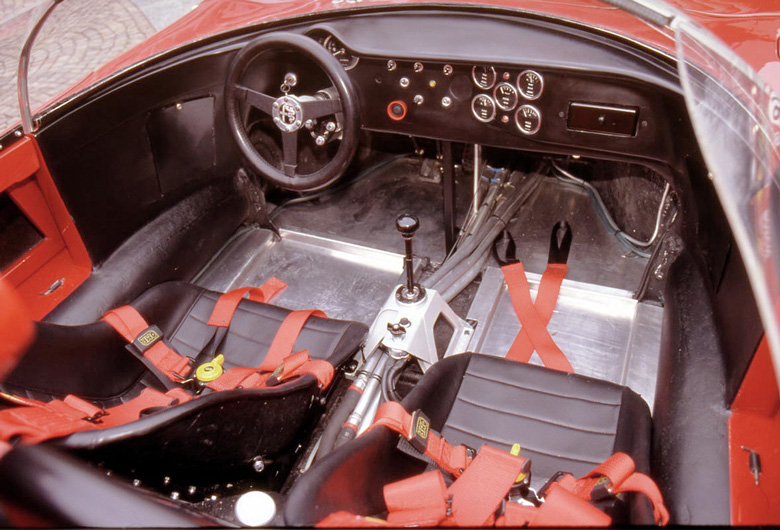
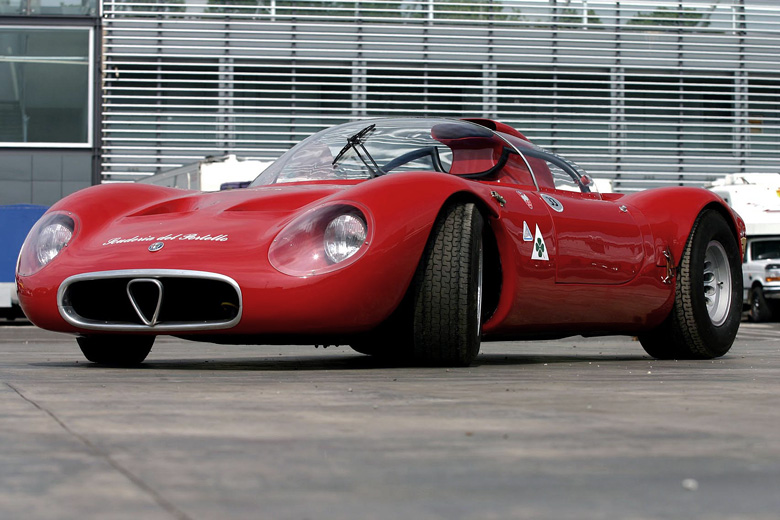
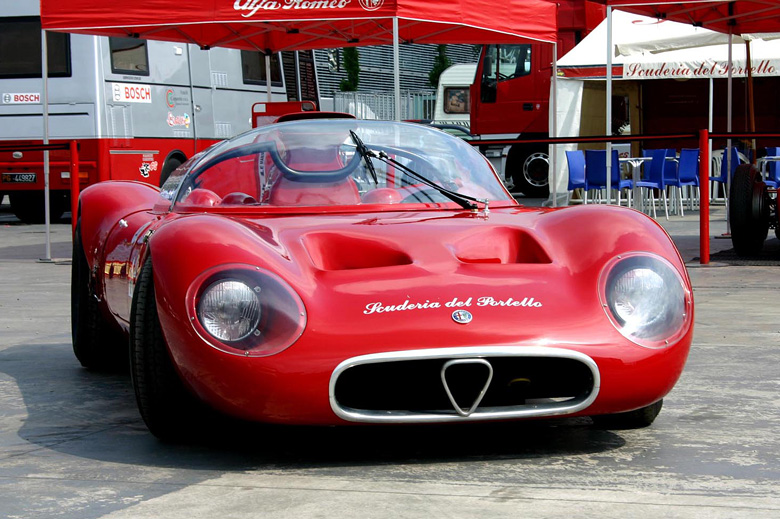
Can you shed any light on who designed the lovely shape? I’ve admired the compact, seductive shape of this car ever since I first read about it. The windshield is reminiscent of it’s contemporaries, the sensuous Ferrari Dinos. Franco Scaglione did the prettiest of the Stradale-bodied versions, but I’ve never read that he had a hand in the original prototype, so who did?
Also, your article says the three large tubes that form the u-shaped chassis were made of aluminum. I thought I read years ago that they were made of cast magnesium (as well as the front subframe), but I could be mistaken… Is it possible that the originals were cast in Magnesium but later replaced with Aluminum for age-related safety reasons?
What an incredibly beautiful motor
The 1967 T33 was not a development of Osi-Scarabeo show cars. One of the new h-shape chassis was sent to Osi for them to experiment with. This car is in the Arese museum.
The chassis was not aluminium tube…it was magnesium. Chassis 001 won at Fleron, not Fluron. Cajani had a new chassis made by Geordenengo in Cuneo but retains the original chassis.
Motta proves nothing about the name T33/2. The cars were unofficially called several names….T33, T33/2, Periscopica, and those names changed over time depending who was writing about them or who at Alfa Romeo was applying labels. Fleron became the name for 001 which won at Fleron, and has been misused for other cars. As a group all the 1967 cars could be called Periscopica because of the air intake, though the longer tail car used at Mugello was referred to as the Mugello. Anyone who thinks they can ‘prove’ things about Autodelta and T33s is presumptuous as truth was fluid.
A shame Motta didn’t tackle how many 1967 race cars were built….that is still part mystery that I continue to work on.
Ed
Ed,
Good to hear from you! Ya, We are aware of some of the problems but remember this was written almost ten years ago and we did not update it with any current information aside from the fact that Cajani still owns the car. We do look forward to any knew information about the 1967 race cars!
Pete
Ed,
I hope this will clarify some of your concerns….
Fléron was a typo and now corrected. Below are comments from Roberto Motta.
*About the ‘The 1967 T33 was not a development of Osi-Scarabeo show cars’.
This is obvious. But, the Scarabeo was built during 1966 season, and the car use the h-shape chassis. The 33/2 is not a direct development of the Scarabeo, but was built one year later, and it is also featured in your excellent book, “Alfa Romeo Tipo 33 The development and racing history.”
*The car was not aluminum … ‘it was in magnesium…’
I have a copy of the old paper that I received from Alfa Romeo in which there is a comment that the central parts of tube was not in magnesium, but in aluminum (alluminio).
Here is the text: “Ogni sua parte è stata realizzata con il materiale più idoneo alle sue funzioni. I tre grossi tubi a sezione circolare (diametro 20 cm) in alluminio (spessore 2,5 mm) sono rivettati a forma di H assimmetrico…”
And translation: “every part of it has been realized with the material more adact to its functions. The three large tubes with circular cross-section (diameter 20 cm) in aluminum (2.5 mm thick) are riveted in an asymmetric H shape…”
However I think that the chassis was constructed with ‘Peraluman’, a particular aluminum alloys in which the magnesium is present in percentages under the 6%, and this could be the different interpretation. Peraluman was used also for the GTA.
The front and the rear structures of the chassis, where the front suspension and rear suspension are mounted was in Electron, (a Magnesium Alloy in which the aluminum is in varying amounts depending on the type, but is usually less than 10%. Other common elements in this type of alloys are zinc and manganese.)
Moreover, if you read a publication signed by Marco Fazio, who until a few years ago was one of the managers of ‘Automobilismo Storico Alfa Romeo’, ie the Alfa Romeo documentation center and the Arese Museum, writes about the chassis built in aluminum.
Lastly, in your book, page 22, you describe the frame as ‘…made from three pieces of aluminum tubing 5ft long and 8in in diameter.” And later you describe the mounting points of magnesium.
*‘Motta proves nothing about the name T33/2’
The same document, write about the presentation of the Alfa Roemo 33 at Balocco named the car as Alfa Romeo 33/2.
The name T33 or Tipo 33 (type 33 was the project name), and I agree with you that that the car was called in several names T33/2, Periscopica or Daytona, and in other moment some versions was called ‘Tipo Monza’, Tipo Le Mans’ and some other name.
About the 001 and Cajani, and the new chassis I know the story. Ed, you are a driver, and I have a question, did you would feel safe to run on the track with a frame in ‘magnesium’ that is 50 years old? I would not feel safe and, as Cajani did, I would use a new frame and I would maintain the old one for keep alive the story of the car.
Finally, my goal was to briefly cover the Cajani Alfa, not to delve into other serial numbers.
It never ceases to amaze me just how much knowledge is out there and gathered for history through Veloce Today.
Just goes to show what a wonderful production it is.
Roberto Motta replies:
Peter, thank and follow VT weekly as we have many other interesting stories for our readers.
Roberto Motta replies:
George, yes it is a wonderful engine, that allowed the T33 to become a great racecar.
Roberto Motta replies:
Sorry for my late answer.
The chassis itself was not in magnesium, but aluminum; read my complete answer to Ed’s comment. About the body, I know that was a Franco Scaglione design, but I have no document that proves this…so if some readers have more information about this, it would be most welcome.
Around 1969, I went to a race meet at Seattle International Raceway. The 2L T33 was there. Can’t remember if it was racing or on demonstration.
Driver was Scooter Davis (maybe Davies?).
Impressively quick through the double hairpins and lower part of the course.
For Bob Hoye,
That 33 was driven by Scooter Patrick for Otto Zipper……as I remember.
Don Black
Bob,
Could you be referring to Scooter Patrick – who drove an Otto Zipper Alfa T33 in 1969?
– Dan
Read more: http://autoweek.com/article/other-motorsports/sports-car-racer-scooter-patrick-1932-2016#ixzz52QY8sTIm